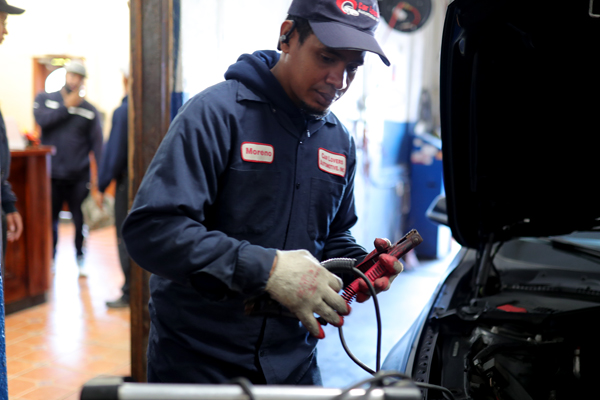All Categories
Featured

Preserving your vehicle's tires is crucial to ensure a smooth, safe, and reliable driving experience. Two key services that are frequently forgotten yet have a considerable effect on tire durability and efficiency are tire turning and positioning. These solutions help maintain your vehicle running successfully and protect against unequal tire wear that can impact both safety and fuel economic situation. Let's dive into what tire rotation and positioning are and why they're important for your car.
What Is Tire Turning? Tire rotation is the process of relocating your tires from one placement to one more to ensure they put on evenly. Considering that your car's tires operate at different prices relying on their placement (front tires versus rear tires), turning them frequently helps to distribute the wear uniformly, bring about a longer lifespan for your tires.
Tires on the front axle tend to use much more quickly than those on the back axle, specifically in front-wheel-drive autos, where the front tires handle both steering and power. On the various other hand, rear tires might put on erratically depending on the automobile's weight distribution and driving problems. By revolving your tires every 6,000 to 8,000 miles (or as advised by the manufacturer), you'll make certain a much more well balanced wear pattern.
What Is Tire Alignment? Tire alignment, additionally known as wheel positioning, refers to changing the angles of your vehicle's wheels to the producer's requirements. Proper alignment makes sure that your tires are pointing in the right direction, and it assists optimize tire life and improve lorry handling. There are 3 main elements of positioning: camber, caster, and toe.
Camber refers to the tilt of the tires from the front of the lorry. If your tires are tilted excessive internal or outside, it can create uneven wear. Wheel refers to the angle of the steering axis when checked out from the side of the automobile. This impacts the security of the guiding, especially when driving right. Toe describes the angle at which the tires direct internal or outward when checked out from above. This influences exactly how your automobile tracks when driving. A proper alignment makes certain that all four tires are directing straight in advance and are angled correctly. Imbalance can result from striking pockets, curbs, or just from the wear of suspension components in time.
Why Tire Turning and Positioning Matter. Extended Tire Life. Both tire turning and alignment aid protect against unequal tire wear. When your tires use evenly, they last longer, which can conserve you money in the long run by lowering the demand for premature substitutes.
Improved Safety And Security. Correct tire turning and placement boost automobile stability and handling. Misaligned tires or unevenly worn tires can negatively impact your capacity to steer and stop your car, especially in emergency scenarios. Normal maintenance guarantees your tires execute ideally, offering a much safer driving experience.
Better Gas Efficiency. If your tires are not lined up properly, they may drag against the roadway surface area, creating resistance. This additional rubbing can minimize gas performance, causing your vehicle to take in even more gas. Regular tire placement makes certain that your lorry relocates successfully, boosting gas mileage.
Boosted Convenience. Misalignment or unevenly worn tires can result in a rougher adventure, as your vehicle might pull to one side or create resonances. By keeping your tires turned and lined up, you'll delight in a smoother and extra comfy driving experience.
Indicators That Your Tires Need Rotation or Positioning. It's crucial to remain alert for any signs that your tires need rotation or alignment. Watch out for these typical indications:
Irregular Tire Wear: If you notice that tire is significantly more used than the others, it may be time for a rotation or positioning. Steering Pull: If your automobile pulls to one side while driving right, this might show imbalance. Vibrations: If you feel vibrations in the steering wheel or the auto itself, it could be an indicator of imbalance or unequal tire wear. Screeching Tires: Uncommon tire sound could likewise suggest incorrect alignment or the need for a tire rotation. Exactly how Typically Should You Rotate and Align Your Tires? Tire rotation should typically be done every 6,000 to 8,000 miles or as specified in your automobile's proprietor's guidebook. It's a good concept to revolve your tires throughout every oil change, as this will certainly assist you stay on top of routine upkeep.
When it comes to positioning, it does not need as regular service. Typically, placement ought to be checked at least once a year or whenever you see problems like drawing to one side or vibration. You may likewise need positioning if you have actually struck a big pocket or curb, which can toss your wheels out of alignment.
Conclusion: Maintain Your Tires in Leading Forming. Tire turning and alignment are important services that keep your lorry running smoothly, securely, and effectively. By taking the time to have your tires turned and straightened routinely, you're spending in your cars and truck's performance and long life, while also boosting your safety on the roadway. Stay positive with tire upkeep, and your car will certainly thanks with better fuel economic climate, enhanced handling, and prolonged tire life.
Latest Posts
Uncover Exceptional Car Repair Services offered by Montclare Auto Repair – Reliable Repairs Await
Discover Your Wyoming Banking Partner – The Key to Better Banking in Wyoming
Discover WyHy FCU – Top Benefits for Your Financial Success
More
Latest Posts
Uncover Exceptional Car Repair Services offered by Montclare Auto Repair – Reliable Repairs Await
Discover Your Wyoming Banking Partner – The Key to Better Banking in Wyoming
Discover WyHy FCU – Top Benefits for Your Financial Success